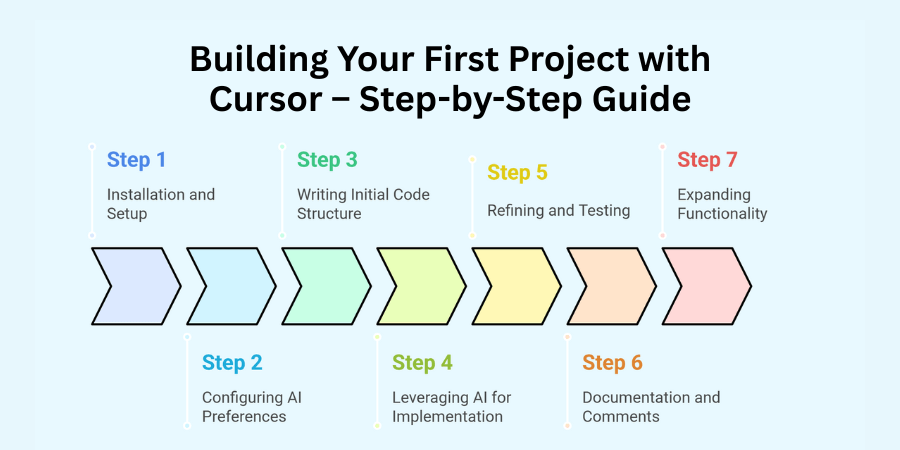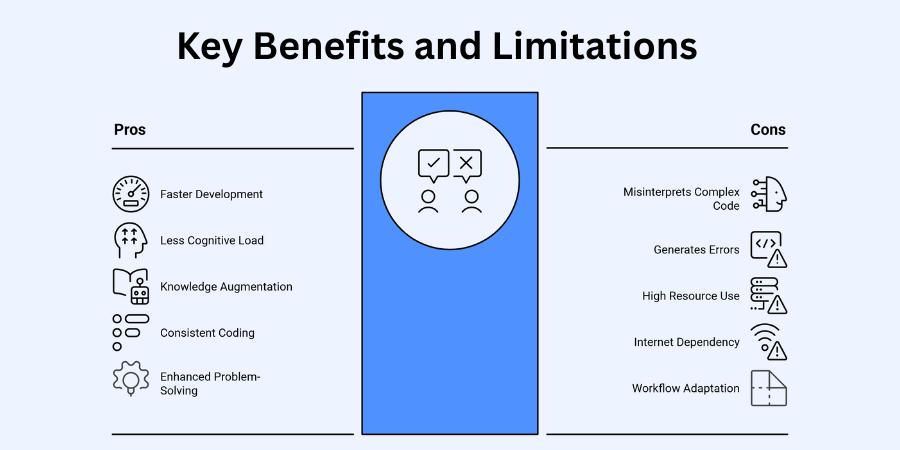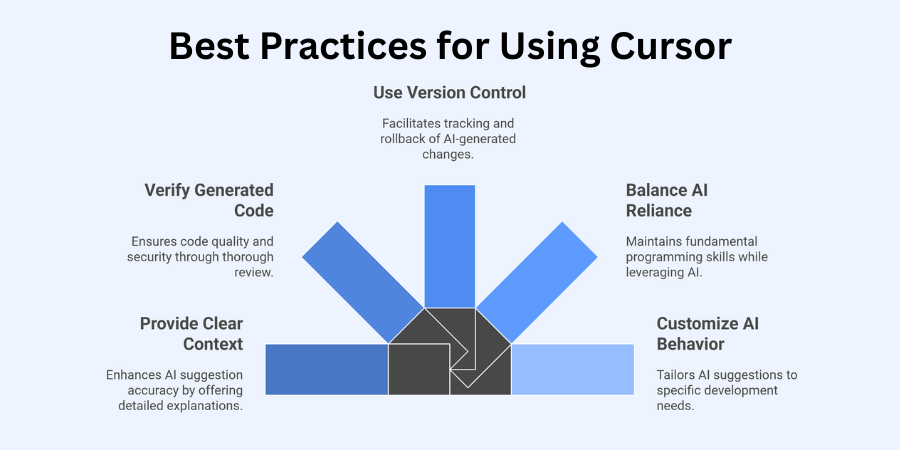The Ultimate Guide to Using Cursor AI for Faster Development in 2025

Table of Contents
Artificial intelligence continues to revolutionize software development through innovative tools that enhance productivity and creativity. Cursor AI represents a significant advancement in this evolution as an AI-native code editor designed for modern developers. Learning how to use Cursor AI can transform your coding workflow by combining familiar editing capabilities with powerful AI assistance. This comprehensive guide explores how to use Cursor AI effectively across various development scenarios and project types. You will discover essential features, practical applications, and best practices that make Cursor AI a valuable addition to any developer’s toolkit. From installation to advanced techniques, this guide provides everything needed to leverage AI-assisted development for faster, smarter coding experiences.
Table of Contents
What is Cursor?
Cursor is an AI-first coding environment built specifically for developers seeking intelligent assistance throughout their workflow. This innovative platform builds upon the familiar foundation of Visual Studio Code while integrating advanced AI capabilities directly into the development experience. The editor maintains the interface elements VS Code users recognize while adding powerful AI features for code generation and manipulation. Cursor connects with large language models to understand context, suggest solutions, and help developers overcome common coding challenges.
The platform offers both free and premium tiers to accommodate different user needs and project requirements. Developers can access AI assistance for writing new functions, refactoring existing code, or generating documentation without switching contexts. Cursor represents a new approach to development tools where AI serves as an active participant rather than a passive helper. The integration feels natural and enhances productivity without disrupting established coding patterns or preferences.
How Does Cursor AI Work?
Cursor AI operates by connecting your coding environment directly to powerful large language models like GPT-4. The system analyzes your codebase to establish context about your project structure, dependencies, and programming patterns. This contextual understanding allows Cursor to generate relevant suggestions that align with your existing code style and architecture. The AI processes both the code you have written and natural language instructions you provide through comments or chat.
When you request assistance, Cursor sends the relevant context to the language model and receives generated code or explanations in return. The editor displays these suggestions inline where you can accept, modify, or reject them based on your requirements. Cursor maintains awareness of your entire project rather than just individual files, enabling more coherent assistance across complex codebases. The AI can reference multiple files simultaneously to understand relationships between components and provide more accurate suggestions.
The system continuously improves its understanding of your code as you interact with it throughout development sessions. Cursor learns from your acceptance or rejection of suggestions to better align with your preferences over time. The communication between your local environment and the AI happens securely while preserving the privacy of your code according to established data policies.
Key Features of Cursor AI
Cursor AI offers several standout capabilities that distinguish it from traditional code editors:

AI Pair Programming
The editor provides real-time collaboration with an AI assistant that understands your code context. Developers can discuss problems in natural language and receive contextually relevant solutions. The AI pair programmer can suggest alternative approaches, identify potential issues, and explain complex code sections. This feature simulates working with an experienced developer who understands your project’s architecture and goals.
Intelligent Code Completion
Cursor extends beyond traditional autocomplete by suggesting entire functions and code blocks based on context. The system analyzes surrounding code to generate completions that maintain consistent style and functionality. These suggestions often include proper error handling, documentation, and optimizations that might otherwise be overlooked. The completions adapt to your coding patterns and project requirements over time.
Bug Detection and Resolution
The AI identifies potential bugs and logic errors before they cause runtime issues. Cursor highlights problematic code sections and suggests specific fixes with explanations. The system can detect edge cases, performance bottlenecks, and security vulnerabilities during development. This proactive approach reduces debugging time and improves overall code quality.
Code Explanation and Documentation
Developers can highlight complex code sections and request plain-language explanations of functionality. Cursor generates comprehensive documentation for functions, classes, and modules with minimal effort. The explanations include purpose, parameters, return values, and potential side effects. This feature particularly benefits teams working with legacy codebases or complex algorithms.
Inline Code Generation
Cursor can generate implementation code based on function signatures or comments describing desired behavior. Developers can describe requirements in natural language and receive working code that meets specifications. The generated code follows project conventions and integrates seamlessly with existing functionality. This capability accelerates development of boilerplate code and common patterns.
Use Cases of Cursor AI
1. Automated Code Generation for Faster Development
Cursor AI accelerates software development by generating code snippets, functions, and even complete modules based on natural language prompts.
Industries Served:
Software development companies, startups, IT services providers, and internal tech teams in various industries.
How It Works:
Developers describe the feature or function they need in plain language, and Cursor AI suggests optimized, ready-to-use code in the chosen programming language.
Impact:
Speeds up development cycles, reduces manual coding effort, and ensures better productivity for development teams.
Real-World Example:
A fintech startup used Cursor AI to quickly build a secure payment gateway integration, reducing delivery time by 40%.
2. Debugging and Error Fixing
Cursor AI helps identify and resolve coding errors in real time, minimizing downtime and improving code reliability.
Industries Served:
Any software-driven industry including SaaS, finance, healthcare tech, and e-commerce platforms.
How It Works:
The AI scans the code, detects syntax or logical errors, and provides clear explanations with suggested fixes.
Impact:
Improves software stability, reduces developer frustration, and shortens bug-resolution time.
Real-World Example:
An e-commerce platform resolved recurring checkout page errors using Cursor AI’s debugging suggestions, improving user experience and sales conversion rates.
3. Code Refactoring for Performance Optimization
Cursor AI enhances code performance by restructuring and optimizing existing code without altering its functionality.
Industries Served:
Tech companies, gaming studios, mobile app developers, and enterprise software teams.
How It Works:
It analyzes existing codebases, identifies inefficiencies, and rewrites them for better speed, scalability, and maintainability.
Impact:
Leads to faster application performance, reduced resource consumption, and easier long-term maintenance.
Real-World Example:
A gaming company improved frame rates and reduced lag by refactoring core game logic with Cursor AI’s assistance.
4. Learning and Onboarding Support for Developers
Cursor AI acts as a learning companion for new developers, offering explanations and coding best practices.
Industries Served:
EdTech companies, corporate IT training, coding bootcamps, and tech startups onboarding new hires.
How It Works:
Developers can ask questions directly in the coding environment, and Cursor AI provides contextual guidance with examples.
Impact:
Accelerates the onboarding process and boosts the confidence of junior developers.
Real-World Example:
A SaaS company onboarded three junior developers in half the usual time using Cursor AI as an integrated learning tool.
5. Multi-Language Code Translation
Cursor AI translates code between programming languages, enabling cross-platform development without rewriting from scratch.
Industries Served:
Global software firms, freelance developers, and companies transitioning between tech stacks.
How It Works:
The AI interprets the logic of the source code and rewrites it in the target programming language with equivalent functionality.
Impact:
Saves significant time when migrating systems or expanding to multiple platforms.
Real-World Example:
A healthcare tech firm converted a Python-based analytics tool to JavaScript for web deployment using Cursor AI in two days instead of two weeks.
6. AI-Powered Code Documentation
Cursor AI automatically generates clear, structured documentation for codebases, making it easier for teams to understand and maintain projects.
Industries Served:
Software development companies, SaaS providers, enterprise IT teams, and open-source project contributors.
How It Works:
The AI scans the code, identifies functions, variables, and workflows, and creates human-readable documentation with explanations and usage examples.
Impact:
Reduces time spent on manual documentation, improves collaboration, and ensures smooth project handovers.
Real-World Example:
An enterprise IT department used Cursor AI to document a large internal system, cutting documentation time by 60% and improving developer onboarding.
7. Test Case Generation and Automation
Cursor AI helps developers create unit tests, integration tests, and automated testing scripts to ensure software quality and stability.
Industries Served:
QA teams, SaaS providers, enterprise software companies, and mobile app development firms.
How It Works:
It analyzes code logic, predicts potential edge cases, and generates automated test scripts tailored to the application’s requirements.
Impact:
Increases test coverage, reduces bugs in production, and accelerates release cycles.
Real-World Example:
A mobile app development team used Cursor AI to create automated regression tests, reducing post-release bugs by 45%.
Building Your First Project with Cursor – Step-by-Step Guide

Step 1: Installation and Setup
Begin by downloading Cursor from the official website (cursor.sh) and following the installation instructions for your operating system. Launch the application and complete the initial configuration process including authentication. The interface resembles VS Code with additional AI-specific controls in the sidebar and command palette. Create a new project folder or open an existing one to begin working with your code.
Step 2: Configuring AI Preferences
Access the settings menu to customize AI behavior according to your preferences and project requirements. Configure the language model, response length, and code style parameters that align with your development standards. Adjust the suggestion frequency to balance assistance and distraction based on your working style. These settings can be modified at any time as you become more familiar with the tool.
Step 3: Writing Initial Code Structure
Start by creating the basic structure of your project including main files and directories. Add comments describing the purpose and functionality of key components to provide context for the AI. Write function signatures or class definitions with descriptive names that communicate their intended purpose. This foundation helps Cursor understand your project architecture and generate more relevant suggestions.
Step 4: Leveraging AI for Implementation
Select a function or component you want to implement and position your cursor at the appropriate location. Press Ctrl+K followed by Ctrl+G (or use the command palette) to activate the AI code generation. Provide a clear description of the functionality you need in natural language. Review the generated code, making adjustments as necessary to meet your specific requirements.
Step 5: Refining and Testing
Examine the AI-generated code carefully to ensure it follows best practices and meets your requirements. Run tests to verify functionality and performance under various conditions. Use the AI chat feature to ask questions about specific implementation details or potential improvements. Iterate on the code by requesting refinements or alternative approaches when needed.
Step 6: Documentation and Comments
Ask Cursor to generate documentation for your functions and classes using the appropriate commands. Review and edit the generated documentation to ensure accuracy and completeness. Add additional context or examples where the automatic documentation might be insufficient. This practice ensures your project remains maintainable even as it grows in complexity.
Step 7: Expanding Functionality
Continue building your project by repeating steps 4-6 for additional components and features. Use the AI to help with challenging algorithms or complex logic by describing the problem clearly. Leverage Cursor’s ability to reference multiple files when implementing features that span across different modules. The AI maintains consistency across your expanding codebase.
Benefits of Using Cursor

Cursor provides several significant advantages for developers:
Accelerated Development Speed: Reduces time required for implementing common patterns and structures
Reduced Cognitive Load: Handles implementation details while developers focus on higher-level architecture
Knowledge Augmentation: Serves as an always-available expert in multiple programming languages and frameworks
Consistency Across Projects: Maintains coding standards and patterns throughout projects regardless of team size
Enhanced Problem-Solving: Enables exploration of multiple solution approaches quickly with AI assistance
These benefits combine to create a more efficient and effective development experience that enhances both productivity and code quality.
Limitations of Using Cursor AI
Despite its advantages, Cursor AI has several important limitations to consider:
Code Understanding Boundaries: Sometimes misinterprets complex project structures or domain-specific patterns
Hallucinations and Inaccuracies: Occasionally generates plausible-looking code containing subtle errors
Performance Considerations: Increases resource consumption compared to traditional editors
Internet Dependency: Requires active internet connection for AI features to function
Learning Curve Adjustment: Necessitates adapting existing workflows and communication styles
Best Practices for Using Cursor
 Provide Clear Context
Provide Clear Context
Write descriptive comments and function names that clearly communicate intent to the AI. Structure your code logically with appropriate separation of concerns for better understanding. Begin complex functions with comments explaining the algorithm or approach you intend to use. This context dramatically improves the relevance and accuracy of AI suggestions.
Verify Generated Code
Always review AI-generated code thoroughly before committing to production environments. Test edge cases and boundary conditions that might not be obvious from implementation alone. Verify that generated code follows security best practices and handles errors appropriately. Consider peer reviews for critical sections even when AI assistance seems confident.
Use Version Control Effectively
Commit code frequently to track changes and enable easy rollback of problematic AI suggestions. Create separate branches for experimental features that rely heavily on generated code. Document which portions of the codebase received significant AI contribution for future reference. This practice provides safety nets when exploring new approaches with AI assistance.
Balance AI Reliance
Maintain your fundamental programming skills rather than becoming dependent on AI suggestions. Use Cursor as a collaborative tool rather than a replacement for understanding core concepts. Practice implementing critical algorithms manually before requesting AI assistance. This balanced approach ensures continued growth as a developer while leveraging productivity benefits.
Customize AI Behavior
Adjust Cursor settings to match your specific development style and project requirements. Create project-specific configuration files that guide AI toward domain-appropriate suggestions. Provide feedback on suggestions to help the system learn your preferences over time. These customizations improve the relevance and usefulness of AI assistance.
Cursor AI vs. Regular Code Editors
Feature Cursor AI Traditional Editors (VS Code, Sublime)
Code Completion Context-aware completion of entire functions and blocks Limited to variable names, methods, and simple snippets
Error Detection Proactive identification of logical errors and edge cases Primarily syntax errors and linting warnings
Documentation Automatic generation of comprehensive documentation Manual documentation or basic snippet templates
Learning Curve Moderate learning curve to effectively communicate with AI Familiar interface with standard development patterns
Offline Usage Limited functionality without internet connection Full functionality available offline
Resource Usage Higher memory and CPU requirements Lower resource footprint
Customization AI behavior and code generation preferences Editor appearance and keyboard shortcuts
Code Explanation Interactive explanation of complex code sections No built-in explanation capabilities
Refactoring Intelligent suggestions for structural improvements Basic rename and extract operations
Cost Free tier with premium features requiring subscription Mostly free with some paid extensions
Cursor excels in scenarios requiring rapid development, learning new technologies, or working with complex algorithms. Traditional editors remain advantageous for performance-critical environments, offline work, or highly specialized domains. Many developers adopt a hybrid approach, using Cursor for exploration and initial implementation while switching to traditional editors for fine-tuning and optimization.
Conclusion
Cursor AI represents a significant evolution in development tools by deeply integrating artificial intelligence into the coding workflow. Learning how to use Cursor AI effectively can substantially enhance productivity while maintaining code quality and developer autonomy. The platform bridges the gap between traditional programming and AI assistance without sacrificing the control developers need over their code. As AI capabilities continue advancing, tools like Cursor will likely become essential components of modern development environments.
The benefits of accelerated development, reduced cognitive load, and knowledge augmentation make Cursor particularly valuable for both individual developers and teams. While limitations exist regarding perfect code understanding and occasional inaccuracies, following best practices mitigates these concerns effectively. Developers who balance AI assistance with fundamental programming knowledge gain the most advantage from this technology. Cursor AI stands as a powerful complement to developer expertise rather than a replacement for essential skills and understanding.
Frequently Asked Questions
Is Cursor AI free to use?
Cursor offers a free tier with access to basic AI features and limited usage quotas. Premium features require a subscription that unlocks advanced capabilities and removes usage restrictions. Educational institutions may qualify for special pricing or expanded free access.
Can Cursor work with any programming language?
Cursor supports most mainstream programming languages including JavaScript, Python, Java, C++, and many others. Performance and suggestion quality may vary depending on language popularity and available training data. The system continues expanding language support through regular updates.
Does Cursor require internet access at all times?
Yes, Cursor requires an active internet connection to communicate with AI servers for code generation and analysis. Basic editing features function offline, but AI-assisted capabilities become unavailable without connectivity. Local models are not currently supported.
How secure is my code when using Cursor AI?
Cursor implements encryption for data transmission and follows industry-standard security practices. The company’s privacy policy details how code data is processed and stored. Organizations with strict security requirements should review these policies before implementation.
Can Cursor integrate with existing development workflows and tools?
Cursor supports standard Git operations and can be configured to work with most development tools. The editor recognizes project configuration files from popular frameworks and build systems. Integration with CI/CD pipelines follows similar patterns to VS Code deployments.
Shaif Azad
Related Post
Top 10 AI Development Companies in New Jersey for Business
Are you searching for the perfect AI development partner in New Jersey? Have you wondered which...
Top 10 AI Development Companies in New Hampshire
Are you watching New Hampshire’s tech landscape transform before your eyes? Your state is quietly becoming...
Top AI Companies in Nebraska Every Business Should Know
Are you a Nebraska business owner wondering how artificial intelligence could transform your operations? Picture this...




